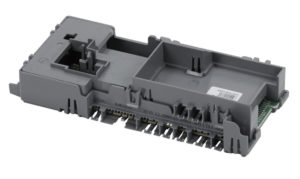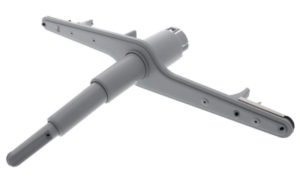Is your dishwasher abruptly stopping in the middle of a cycle, leaving water undrained? We understand how frustrating that can be. In this comprehensive guide, we’ll explore the potential causes behind this issue, including the dishwasher stops mid-cycle, and provide you with practical solutions to fix it.
Experiencing the annoyance of a dishwasher that halts mid-cycle and fails to drain water is a common problem faced by homeowners and renters alike. However, fear not, as we’ll delve into the likely reasons why your dishwasher stops mid-cycle and fails to drain, and offer effective remedies to resolve the issue.
Potential Reasons Why a Dishwasher Fails to Drain Water
There are several potential culprits behind a dishwasher abruptly stopping mid-cycle. Let’s take a look at some of the most common ones:
The Door Latch is Loose
If you suspect a loose door latch to be the cause of your dishwasher’s mid-cycle interruptions, follow these steps to address the issue:
- Turn off the dishwasher’s power. You can unplug it or switch off the circuit breaker.
- Inspect the door latch for signs of damage or wear.
- Attempt to tighten the screws of the door latch and observe if the problem is resolved.
- If tightening the screws doesn’t rectify the issue, consider replacing the door latch.
- Test the dishwasher to ensure it functions properly.
To maintain the door latch in optimal condition, keep in mind the following tips:
- Regularly clean the door latch to prevent buildup and ensure proper functioning.
- Avoid slamming the dishwasher door, as it can damage the latch.
The Thermal Fuse is Shorting Out
A shorted thermal fuse can also lead to mid-cycle disruptions in your dishwasher. Follow these steps to address this potential issue:
- Turn off the dishwasher’s power. You can unplug it or switch off the circuit breaker.
- Locate the thermal fuse, typically found on the control board or at the back of the dishwasher.
- Use a multimeter to test the thermal fuse for continuity. If there is no continuity, it signifies a shorted thermal fuse that needs replacement.
- Remove the old thermal fuse and install the new one according to the manufacturer’s instructions.
- Test the dishwasher to ensure it functions properly.
To maintain the thermal fuse’s efficiency, consider the following tips:
- Regularly clean the dishwasher to prevent overheating and ensure the thermal fuse operates smoothly.
- Avoid overloading the dishwasher, as this can cause overheating and trigger the thermal fuse.
By addressing these common issues, you can troubleshoot and resolve the problem of a dishwasher that starts then stops mid-cycle and fails to drain water. Remember to exercise caution and consult a professional if needed to ensure proper repairs and maintenance of your dishwasher.
Electronic Control Board Shorting Out
A malfunctioning electronic control board can also be the culprit behind mid-cycle interruptions or improper functioning of your dishwasher, including when it stops after 2 minutes. Follow these steps to troubleshoot a potentially shorted electronic control board:
- Check if the dishwasher is properly plugged in and if the circuit breaker is not tripped.
- Initiate a wash cycle and observe the control board to identify any malfunctions or signs of shorting out.

- Disconnect the power to the dishwasher by unplugging it or turning off the circuit breaker.
- Remove the control panel to access the electronic control board.
- Inspect the control board for visible damage such as burns or corrosion. If damage is evident, the control board needs replacement.
- Verify the wiring connections to the control board, ensuring they are secure and undamaged.
- Test the control board using a multimeter set to the ohms setting. Check the readings against the expected range. If the reading is outside the norm, consider replacing the control board.
There May Be an Issue with Your Pump and Motor
Let’s delve into the details of some potential causes for problems related to the pump and motor in your dishwasher:
- Clogged pump: When the pump gets clogged with debris or food particles, it impedes proper water circulation, leading to mid-cycle interruptions.
- Damaged impeller: The impeller, responsible for moving water through the dishwasher, can become damaged or broken, hindering water circulation.
- Burnt-out motor: The motor powers the pump and facilitates water circulation. If the motor is burnt out or malfunctioning, it can cause the dishwasher to stop mid-cycle.
- Faulty motor capacitor: The motor capacitor aids in starting the motor. If it’s faulty, the motor may not start correctly, resulting in mid-cycle interruptions.
- Worn-out bearings: Both the pump and motor rely on bearings to function smoothly. If these bearings wear out, it can cause malfunctions in the pump and motor, leading to dishwasher issues.
To address problems with the pump and motor, it’s crucial to diagnose the specific cause of the problem. This typically involves inspecting these components for damage or wear, testing the motor’s continuity, and cleaning any debris or buildup in the pump. In some cases, replacement of the pump and motor may be necessary.
Fan Assembly
The fan assembly plays a vital role in the cooling system of your dishwasher, preventing the motor from overheating during operation. Typically located near the dishwasher motor, it consists of a motor, a fan blade, and a housing. The fan blade draws cool air into the housing and directs it over the motor, ensuring proper cooling.
If the fan assembly malfunctions, it can lead to motor overheating, resulting in mid-cycle interruptions or even failure to start. Overheating can also cause damage to other dishwasher components, necessitating costly repairs.
If you suspect issues with the fan assembly, address them promptly. Check the fan blade and housing for any signs of damage or wear. If the blade is bent or the housing is cracked, replacement is necessary.
If the fan assembly appears to be in good condition but the motor still overheats, the problem may lie with the motor itself. In such cases, consulting a professional technician for diagnosis and resolution is recommended. They may suggest motor replacement or repair of other components to resolve the issue.
Overloading
Overloading your dishwasher can lead to various problems, including damage to the pump and motor. Excessive load places strain on these components, causing them to wear out faster compared to when the dishwasher is properly loaded. This can result in costly repairs or even necessitate replacing the entire dishwasher.
To avoid overloading, adhere to the manufacturer’s guidelines for dishwasher loading. Ensure dishes are not stacked too high or obstruct the spray arm, as this prevents proper water and detergent distribution. Avoid placing large items like pots and pans in the dishwasher, as they occupy excessive space and hinder proper functioning.
If you consistently find yourself overloading, consider running multiple loads or upgrading to a larger dishwasher that accommodates your needs. By following these recommendations, you can extend your dishwasher’s lifespan and avoid expensive repairs.
Blocked Spray Arm
When your dishwasher stops mid-cycle with water in the bottom, it can be a frustrating experience. This issue can be caused by various factors, including a blocked spray arm. Here’s how you can address this problem:
- Turn off power to the dishwasher by unplugging it or switching off the circuit breaker.
- Locate the spray arm, typically positioned at the bottom and attached with clips or screws.
- Remove any clips or screws securing the spray arm.
- Gently pull the spray arm off the motor shaft to expose it fully. 5. Inspect the spray arm for signs of damage or wear.

- Inspect the spray arm for signs of damage or wear.
- Rinse the spray arm under running water to remove any debris or buildup.
- Use a soft brush to scrub away stubborn residue or buildup.
- Reattach the spray arm to the motor shaft, securing it with the previously removed clips or screws.
- Test the dishwasher to ensure it functions properly and the spray arm operates effectively.
To maintain the spray arm’s performance, keep these additional tips in mind:
- Regularly clean the spray arm to prevent buildup and ensure optimal functioning.
- Avoid overloading the dishwasher, as it places extra strain on the spray arm and motor.
When your dishwasher stops mid-cycle, it can be a frustrating experience. By understanding the potential causes and implementing the provided solutions, you can avoid costly repairs or replacements. If you are unsure how to resolve the issue on your own, it is advisable to seek professional assistance to diagnose and fix the problem effectively.